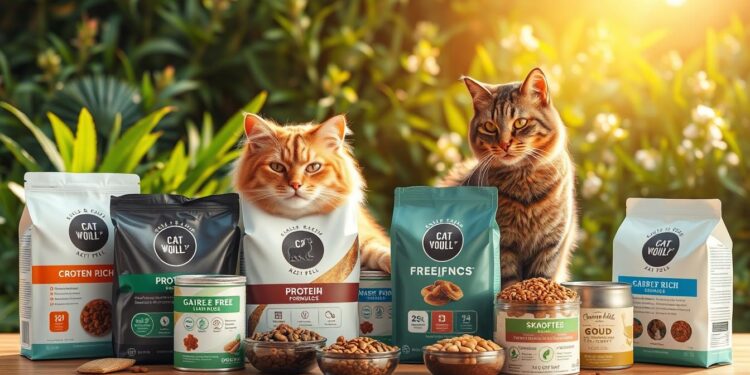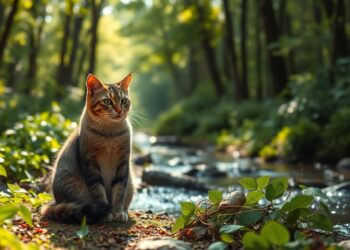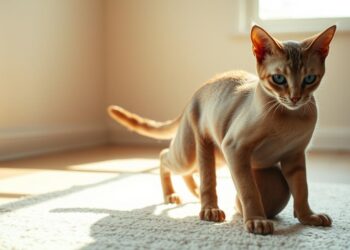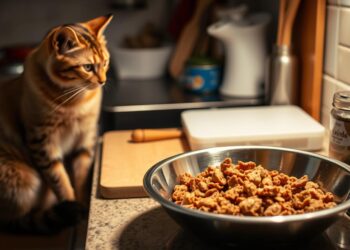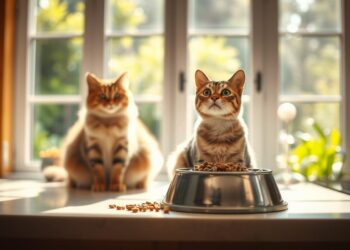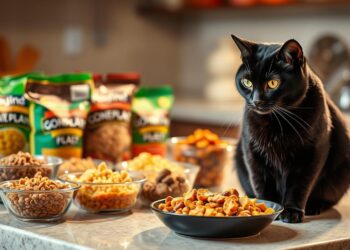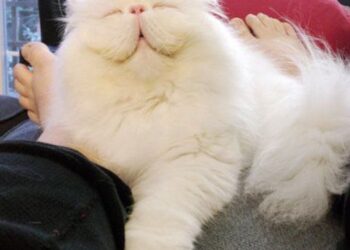As a cat owner, providing your feline friend with a nutritious feline diet is crucial for their overall health and well-being. A well-balanced diet can help maintain your cat’s optimal weight, support their immune system, and promote healthy skin and coat.
With numerous options available, choosing the right dry cat food can be overwhelming. From traditional kibble to high-protein formulas and oven-baked recipes, the variety of dry cat food can cater to different feline needs and preferences.
Understanding the importance of optimal cat nutrition and the benefits of various dry cat food types is essential for making informed decisions about your cat’s diet.
Why Choose Dry Cat Food?
Dry cat food has become a staple in many cat households due to its numerous benefits. One of the primary advantages is its ability to improve dental health by reducing tartar and plaque buildup.
Benefits of Dry Cat Food
Feeding your cat high-quality cat kibble can have several health benefits. It helps in maintaining their dental health and overall well-being. Dry cat food is formulated to provide a balanced diet, ensuring your cat gets all the necessary nutrients.
The texture of dry cat food helps to remove plaque from their teeth, which can lead to healthier gums and fresher breath. Moreover, the act of chewing dry food can help reduce stress and keep your cat’s jaw strong.
Convenience and Storage
One of the significant advantages of dry cat food is its convenience. It is easy to store and can be left out for your cat to graze on throughout the day without spoiling quickly, unlike wet cat food.
To maintain its freshness, it’s essential to store dry cat food properly. Keeping it in a cool, dry place in an airtight container can help preserve its quality.
Cost-Effectiveness
Dry cat food is often more cost-effective than wet cat food, making it an attractive option for many cat owners. The cost per serving is generally lower, and it can be purchased in larger quantities, reducing the overall expense.
When choosing a premium kibble for cats, consider the long-term benefits it provides, including potential savings on veterinary bills due to improved health. While the initial cost might seem higher for high-quality brands, the overall value can be more economical.
Key Nutritional Needs for Cats
As obligate carnivores, cats require a diet rich in certain nutrients to thrive. Their nutritional needs are unique and play a significant role in determining their overall health and well-being.
Essential Nutrients for Cats
Cats require a variety of essential nutrients, including vitamins, minerals, and amino acids. These nutrients are crucial for maintaining their bodily functions, from energy production to the health of their coat and skin.
- Vitamins: Important for various bodily functions, including energy production and immune function.
- Minerals: Crucial for maintaining healthy bones, teeth, and bodily functions.
- Amino Acids: The building blocks of proteins, essential for muscle health and other bodily functions.
Importance of Protein
Protein is a critical component of a cat’s diet, given their predatory nature. It is essential for maintaining muscle health, supporting bodily functions, and overall health.
High-quality protein sources are vital, as they provide the necessary amino acids that cats cannot produce on their own. Examples include chicken, salmon, and beef.
Role of Healthy Fats
Healthy fats are another crucial element in a cat’s diet, providing energy and supporting skin and coat health. They also play a role in the absorption of vitamins.
- Omega-3 fatty acids: Support skin and coat health, as well as heart health.
- Omega-6 fatty acids: Important for skin health and other bodily functions.
Ensuring that your cat’s diet is rich in these essential nutrients is key to maintaining their overall health. A vet-recommended cat food that focuses on optimal cat nutrition will provide the necessary components for a healthy life.
Understanding Cat Food Labels
Deciphering the information on cat food labels can be overwhelming, but it’s essential for making informed decisions. Cat food labels contain a wealth of information that can help you choose the best diet for your cat.
Decoding Ingredients
The ingredient list on cat food labels can be confusing, especially for those without a background in nutrition. Ingredients are listed in order of their weight, with the heaviest ingredients first. Look for high-quality protein sources like chicken or salmon as the first ingredient. Be wary of fillers and by-products, which provide little nutritional value.
When examining the ingredient list, it’s also important to understand the difference between named protein sources (e.g., chicken) and generic terms (e.g., meat). Named protein sources are generally considered more desirable as they indicate a specific origin.
AAFCO Standards Explained
The Association of American Feed Control Officials (AAFCO) sets standards for the nutritional content of cat food. AAFCO standards ensure that cat food meets the minimum nutritional requirements for cats. Look for cat food that meets or exceeds AAFCO standards for your cat’s life stage.
AAFCO standards cover various aspects of cat nutrition, including the minimum percentages of crude protein and fat, maximum percentages of crude fiber, and the presence of essential vitamins and minerals.
Identifying Quality Brands
When it comes to choosing a cat food brand, quality matters. Top-rated cat food brands prioritize nutritional adequacy and use high-quality ingredients. Some brands specialize in grain-free dry cat food, which can be beneficial for cats with certain dietary needs.
To identify quality brands, look for transparency about their ingredients and manufacturing processes. Brands that adhere to AAFCO standards and have a history of producing nutritionally balanced food are generally more reliable.
Top Features to Look For in Dry Cat Food
The ideal dry cat food should cater to your cat’s specific needs, whether it’s related to grain content, life stage, or special health requirements. Cats have different nutritional needs at various life stages, and some may require special diets due to health conditions or sensitivities.
Grain-Free vs. Grain-Inclusive
One of the primary considerations when choosing dry cat food is whether to opt for grain-free or grain-inclusive formulas. Grain-free dry cat food has gained popularity due to its potential benefits for cats with sensitivities or allergies. However, it’s essential to understand that not all cats require a grain-free diet.
Grain-inclusive formulas, on the other hand, can provide essential fiber and nutrients. The key is to examine the type of grains used and ensure they are not fillers but rather nutritious ingredients that contribute to your cat’s overall health.
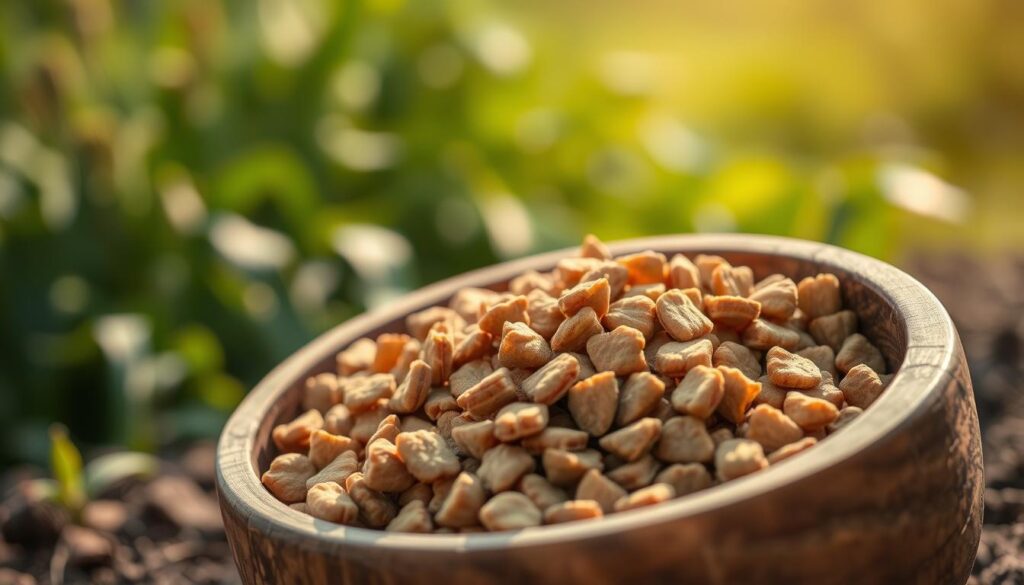
Life Stage Formulas
Cats have different nutritional needs at various stages of their lives. Life stage formulas are designed to meet these specific needs, whether your cat is a kitten, adult, or senior.
- Kittens require higher protein and calorie content to support their rapid growth and development.
- Adult cats need a balanced diet that maintains their overall health and supports their activity level.
- Senior cats may benefit from formulas that support joint health and are easier to digest.
| Life Stage | Nutritional Needs | Key Features |
|---|---|---|
| Kitten | High protein, high calories | Supports growth and development |
| Adult | Balanced diet, moderate protein | Maintains overall health |
| Senior | Easier to digest, joint support | Supports aging joints and digestion |
Special Needs Considerations
Some cats have special needs due to health conditions, allergies, or sensitivities. When choosing dry cat food for these cats, it’s crucial to consider formulas that address their specific requirements.
For example, cats with food sensitivities may benefit from novel protein sources or hypoallergenic formulas. Cats prone to urinary issues may require diets that help maintain urinary health.
Key considerations include:
- Novel protein sources for cats with sensitivities
- Hypoallergenic formulas for cats with allergies
- Urinary health support for cats prone to urinary issues
Best Dry Cat Food Brands on the Market
For cat owners looking for the best dry cat food, brands such as Hill’s Science Diet, Royal Canin, and Blue Buffalo are often at the top of the list due to their superior nutritional content.
These top-rated cat food brands have established themselves through their commitment to quality and nutritional excellence. Here’s a closer look at what each brand has to offer:
Hill’s Science Diet
Hill’s Science Diet is a well-respected brand in the pet food industry, known for its scientifically formulated recipes that cater to the specific needs of cats at different life stages.
- Offers a range of formulas for kittens, adults, and seniors.
- Uses high-quality ingredients to ensure optimal nutrition.
- Has options for cats with specific dietary needs or restrictions.
Royal Canin
Royal Canin is another prominent brand that specializes in creating tailor-made nutrition for cats, with a focus on breed-specific and life-stage formulas.
- Provides a variety of formulas to meet the unique needs of different cat breeds.
- Emphasizes the importance of digestive health in their recipes.
- Offers solutions for cats with specific health concerns.
Blue Buffalo
Blue Buffalo is recognized for its high-quality, natural ingredients and holistic approach to pet nutrition, making it a popular choice among cat owners seeking a more natural diet for their pets.
- Uses real meat as the first ingredient in their recipes.
- Incorporates whole grains, fruits, and vegetables for comprehensive nutrition.
- Avoids the use of artificial preservatives, colors, and flavors.
When choosing a dry cat food brand, it’s essential to consider your cat’s individual needs, including their age, health status, and lifestyle. Consulting with a veterinarian can also provide valuable insights into the best food for your cat.
Dry Cat Food for Specific Health Needs
The right dry cat food can make a significant difference for cats dealing with specific health challenges. Cats with particular health needs require tailored diets that address their unique conditions.
Food for Sensitive Stomachs
Cats with sensitive stomachs benefit from dry food that is easy to digest. Vet-recommended cat food often includes prebiotics and fiber to support digestive health. Brands like Hill’s Science Diet and Royal Canin offer formulas designed to soothe sensitive stomachs.
Weight Management Options
For cats struggling with weight issues, weight management options in dry cat food can be beneficial. These formulas are typically lower in calories and higher in protein to help maintain muscle mass while reducing weight. It’s essential to choose a food that is both nutritious and filling.
Solutions for Allergies
Cats suffering from allergies require dry food that avoids common allergens. Solutions for allergies often involve novel protein sources like venison or salmon, and unique carbohydrates such as sweet potatoes. These ingredients help minimize the risk of an allergic reaction.
When selecting dry cat food for specific health needs, it’s crucial to consult with a veterinarian to determine the best course of action. They can help identify the most suitable food based on the cat’s health condition and nutritional requirements.
Homemade vs. Commercial Dry Cat Food
The decision to feed your cat homemade or commercial dry food depends on several factors, including nutritional balance and convenience. As cat owners weigh their options, understanding the benefits and risks of each choice is crucial.
Benefits of Homemade Diets
Homemade diets offer several advantages, including the ability to tailor the ingredients to your cat’s specific needs. This can be particularly beneficial for cats with food allergies or sensitivities. Customization allows owners to avoid ingredients that may cause adverse reactions.
Another benefit is the potential for using fresh, high-quality ingredients that may not be found in commercial foods. However, it’s essential to ensure that the homemade diet is well-balanced and provides all the necessary nutrients.
| Benefit | Description |
|---|---|
| Customization | Tailor ingredients to your cat’s needs |
| Fresh Ingredients | Use of fresh, high-quality ingredients |
| Nutritional Control | Control over the nutritional content |
Risks of Homemade Formulas
While homemade diets can be beneficial, they also come with risks. One of the primary concerns is nutritional imbalance. Cats have specific dietary needs, and if these are not met, it can lead to health issues.
Another risk is the potential for inadequate supplementation. Cats require certain vitamins and minerals that may not be present in homemade diets if not properly formulated.
When to Choose Commercial
Commercial dry cat food is a convenient and often nutritionally balanced option. It’s formulated to meet the nutritional needs of cats, as defined by organizations such as the Association of American Feed Control Officials (AAFCO).
When deciding between homemade and commercial food, consider your cat’s individual needs and your ability to consistently provide a balanced homemade diet. If you’re unsure, consulting with a veterinarian can provide valuable insights.
| Consideration | Homemade | Commercial |
|---|---|---|
| Nutritional Balance | Requires careful formulation | Formulated to meet nutritional standards |
| Convenience | Time-consuming preparation | Easy to purchase and store |
| Customization | Highly customizable | Limited customization options |
How to Transition Your Cat to Dry Food
A gradual transition to dry food is crucial for maintaining your cat’s digestive health. This process involves several steps that help your cat adjust to the new diet without experiencing adverse reactions.
Gradual Introduction Steps
To introduce dry food successfully, start by mixing a small amount of dry food with their current wet food. Gradually increase the proportion of dry food to wet food over a period of 7-10 days. This allows your cat’s digestive system to adjust.
- Day 1-2: 25% dry food, 75% wet food
- Day 3-4: 50% dry food, 50% wet food
- Day 5-6: 75% dry food, 25% wet food
- Day 7 and beyond: 100% dry food
Signs of Adjustment Issues
Monitor your cat for signs of digestive upset, such as vomiting, diarrhea, or loss of appetite. If you notice any of these symptoms, slow down the transition process.
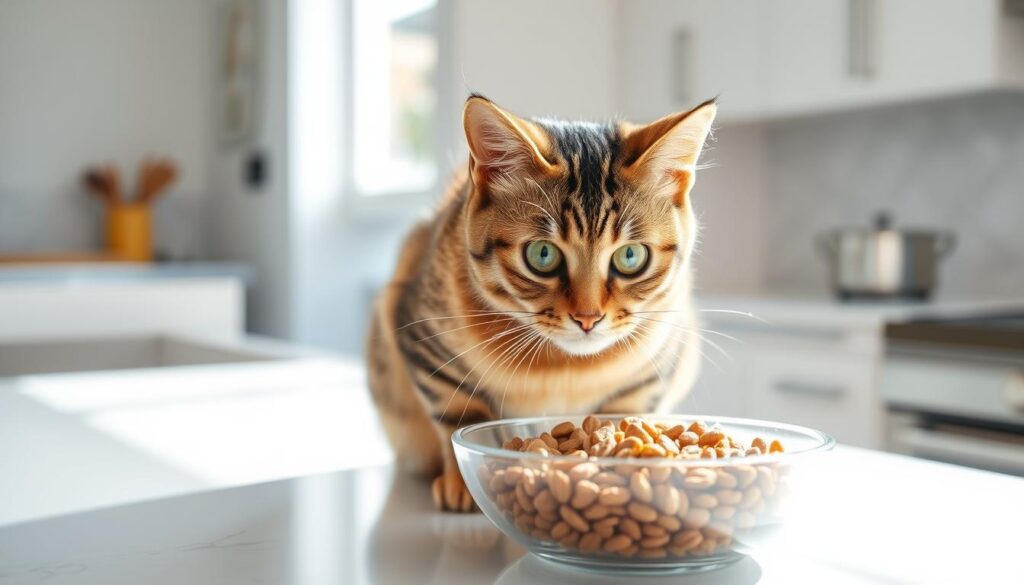
Monitoring Your Cat’s Health
Keep a close eye on your cat’s overall health during the transition. Ensure they are maintaining a healthy weight and show no signs of nutritional deficiencies.
| Health Indicator | Normal Signs | Signs of Concern |
|---|---|---|
| Appetite | Eats enthusiastically | Loss of appetite |
| Stool Quality | Firm, well-formed stool | Diarrhea, constipation |
| Weight | Stable weight | Unexplained weight loss or gain |
Regular veterinary check-ups can help ensure that your cat is adjusting well to the dry food diet.
Comparison: Dry Food vs. Wet Food
Understanding the differences between dry and wet cat food is essential for making an informed decision about your cat’s diet. Both types of food have their unique advantages and disadvantages, which are crucial to consider when deciding what to feed your pet.
Nutritional Differences
Dry cat food and wet cat food differ significantly in their nutritional content. Dry food tends to be higher in carbohydrates and lower in protein compared to wet food. On the other hand, wet food is typically higher in protein and moisture, making it more aligned with a cat’s natural diet.
Nutritional Comparison:
| Nutrient | Dry Food | Wet Food |
|---|---|---|
| Protein | 30-40% | 40-60% |
| Carbohydrates | 30-60% | 0-10% |
| Moisture | 5-10% | 75-85% |
Hydration Considerations
One of the significant advantages of wet food is its high moisture content, which can contribute to a cat’s hydration needs. Cats are naturally adapted to a diet rich in moisture from their prey, and wet food can help maintain their urinary health and overall hydration.
Cost and Convenience
Dry food is generally more cost-effective and convenient than wet food. It has a longer shelf life and can be left out for cats to graze on throughout the day. Wet food, while more expensive, can be more satiating for cats and may reduce the risk of overeating.
- Dry food is more convenient for busy pet owners.
- Wet food can help with weight management.
- Mixing both types can offer a balanced diet.
In conclusion, the choice between dry and wet cat food depends on several factors, including your cat’s nutritional needs, health status, and personal preferences. By understanding the differences between these two types of food, you can make an informed decision that best suits your cat’s requirements.
Tips for Storing Dry Cat Food
To keep dry cat food fresh, it’s vital to store it properly. Proper storage not only maintains the food’s nutritional value but also prevents spoilage and keeps it palatable for your cat.
Keeping Food Fresh
To maintain the freshness of dry cat food, it’s essential to store it in a cool, dry place. Avoid areas near heating vents or direct sunlight, as these conditions can cause the food to degrade. Using airtight containers is also recommended to prevent moisture and pests from getting into the food.
Choosing the right storage location is crucial. Pantries or cupboards are ideal because they are typically cool, dry, and dark. Ensure that the storage area is clean and free from any strong-smelling foods, as dry cat food can absorb odors easily.
Best Containers for Storage
The right container can make a significant difference in maintaining the quality of dry cat food. Plastic or metal containers with tight-fitting lids are excellent choices. They are airtight, which helps to keep the food fresh for a longer period.
- Look for containers that are BPA-free to ensure they are safe for storing food.
- Consider containers with measuring cups or scoops attached for convenience.
- Stackable containers can help save space in your pantry or storage area.
| Container Type | Benefits | Considerations |
|---|---|---|
| Plastic Containers | Lightweight, easy to clean | Ensure they are BPA-free |
| Metal Containers | Durable, pest-resistant | Can be heavy, more expensive |
| Glass Containers | Non-toxic, easy to clean | Can be heavy, breakable |
Importance of Expiration Dates
Checking the expiration date on dry cat food is crucial before purchasing and serving it to your cat. Expired food can lose its nutritional value and may even become harmful to your cat’s health.
Always check the packaging for the manufacturing date and the “best by” date. It’s also a good practice to rotate your stock, using the oldest food first to ensure that none of it expires before being consumed.
Feeding Guidelines and Portions
Figuring out how much dry food your cat needs can significantly impact their overall health and longevity. The amount of dry food a cat requires depends on several factors, including their age, weight, and activity level.
How Much Dry Food Does My Cat Need?
The nutritional needs of cats vary across different life stages. For instance, kittens require more calories and nutrients compared to adult cats, while seniors may need fewer calories but more easily digestible nutrients.
- Kittens (0-12 months): Need nutrient-rich food to support growth and development.
- Adults (1-7 years): Require a balanced diet that maintains their health and energy levels.
- Seniors (8 years and above): May need fewer calories but benefit from higher fiber and easier-to-digest nutrients.
Feeding Schedules Explained
Establishing a consistent feeding schedule is crucial for your cat’s digestive health. Most cats thrive on a twice-daily feeding schedule, but some may require more frequent, smaller meals.
- Divide your cat’s daily ration into 2-3 meals for a regular feeding schedule.
- Consider a free-feeding approach for cats that prefer to graze throughout the day, but monitor their intake to prevent overeating.
Adjustments for Activity Level
A cat’s activity level significantly influences their caloric needs. More active cats require more calories, while less active or indoor cats may need fewer calories to prevent obesity.
- Highly Active Cats: Increase their food portions or switch to a high-energy formula.
- Less Active Cats: Reduce their food portions or switch to a weight management formula.
By understanding and adjusting your cat’s feeding guidelines based on their age, weight, and activity level, you can ensure they receive the optimal amount of nutrition for a healthy life.
Conclusion: Choosing the Best Dry Cat Food
Selecting the right dry cat food involves considering several factors, including nutritional needs, health conditions, and personal preferences. By understanding these elements, cat owners can make informed decisions to ensure their pet’s overall health and well-being.
Nutritional Considerations
Key nutritional needs for cats include essential nutrients like protein and healthy fats. Popular cat food options often highlight these components, but it’s crucial to decode ingredients and understand AAFCO standards to ensure the food meets your cat’s requirements.
Research and Decision-Making
Cat owners are encouraged to research further to find the best dry cat food that suits their cat’s specific needs, whether it’s for a sensitive stomach, weight management, or allergies. Brands like Hill’s Science Diet, Royal Canin, and Blue Buffalo offer a range of formulas that cater to different health conditions.
Final Considerations
In conclusion, choosing the best dry cat food is a critical decision that impacts your cat’s diet and overall health. By considering the factors discussed and exploring popular cat food options, you can provide your cat with a nutritious and balanced diet that supports their well-being.
